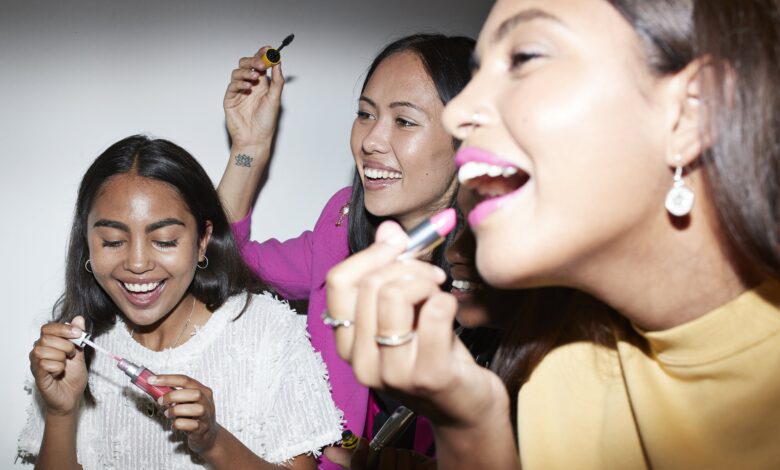The Unspoken Consequence of Calling Beauty Products a “Necessity”

There is a trend going around on TikTok aptly named “underconsumption-core.” In these videos, influencers discuss how they either plan to or are actively cutting back on their spending, particularly as it pertains to fashion and beauty. For the latter category, people are going as far as starting “project pans,” where they set aside a particular number of products every month, in hopes of using them enough that they start to see the bottom of the makeup’s container.
“I don’t think there’s anyone who has a ton of makeup that’s happy with the amount of product that they have,” TikToker Elysia Berman, who is on a no-buy, where she doesn’t purchase any beauty or fashion items for the entire year of 2024, says in one of her videos on the topic. “They all collectively agree that there was something else at play that caused them to buy that many products.”
For many people who grew up in the heyday of YouTube, beauty haul culture has become somewhat normalized. Still, beauty products in particular feel like one of the easiest ways to satisfy the urge to shop, and as such it’s become customary to see people with makeup collections that span multiple Ikea Alex Drawers and even dedicated beauty rooms. But at what point does all this overconsumption lead to hoarding? And are the products that we buy, especially as it pertains to our beauty routines really as necessary as they’re made out to be?
Keep reading to see how the beauty industry may be sneakily encouraging shopping addictions.
Experts Featured in This Article
Carolyn Mair is a chartered psychologist, fashion business consultant, and author of The Psychology of Fashion.
Why Do People Hoard Beauty Products?
There are a few reasons why the beauty industry makes the perfect entryway into a shopping addiction, and many brands play right into those feelings as marketing tactics. “One reason is the emotional gratification and sense of security that beauty products can provide,” psychologist Carolyn Mair, tells PS. “They often symbolize self-care, luxury, and aspiration, and if our reference groups have them, we might feel a sense of FOMO if we don’t get our hands on those items as well.” Have you ever looked at your favorite influencer rave about a product (or five) and suddenly feel an intense urge to get said item? What about a beauty campaign that seems to touch on every single feeling you’re experiencing at a certain point in time — so much so that it feels like a company is speaking directly to you to buy their product?
“Marketing strategies are designed to create desire for consumers,” Mair says. “The need to satisfy this desire is exacerbated when products are promoted as exclusive or with limited-time availability.” When people claim that something will “sell out” or if an item does eventually become unavailable before you can purchase it, you may feel this strong feeling to get your hands on it even more. That fear of missing out, is a feeling that many brands try to create organically to drive up sales of a product, and therefore, earn more profit for its business. As a result of this FOMO, people may not only want to get their hands on a specific product, but also buy multiples in case they ever run out of their favorite item and can never get a hold of it again.
Luxury Beauty As a Signifier of Wealth
Another reason why it’s so much easier to hoard beauty products is because you can get a similar luxury experience that you would when buying a high-end fashion item but for a fraction of the cost. “Luxury beauty products are more accessible and therefore easier to collect for a broader range of consumers, compared to high-end fashion,” Dr. Mair says. “Buying these items can satisfy the desire for prestige and self-indulgence which give a quick emotional boost and can lead to repeat purchasing. This is more about the feel-good factor than the practical need for the product.”
Remember when Dior blushes and subsequently lip oils were all the rage? One of the main reasons why people were buying these items was because they got to add a bit of luxury to their daily routines. This rhetoric is the same one that is used when beauty enthusiasts and collectors buy $50 Chanel compact mirrors or a $30 Aesop hand cream. The product “helps” to elevate the everyday, and otherwise mundane, experience, making the user appear to be more put together than most. These items also act as a signifier of wealth.
“High-end/luxury beauty brands typically convey exclusivity and prestige which are associated with wealth and status, through their price points, packaging and marketing,” Dr, Mair says. “Celebrity endorsements reinforce this by showcasing these items as part of the glamorous lifestyles of the rich and famous.” This is why it’s such a big deal when celebrities sign on to become the face of heritage brands because it’s essentially two standalone brands merging — creating a broader base of potential customers that will buy the product that they are selling.
The Difference Between Collecting and Hoarding
So how do you know if you just have a larger than-normal makeup collection or if you are actually hoarding products? The difference, according to Mair, is the effect that each behavior has on you. “Collecting and hoarding are distinct behaviors,” Dr. Mair says. “Collecting is driven by an appreciation for aesthetics, brand value, and the joy of ownership. It’s like a hobby or status symbol. Whereas, hoarding stems from anxiety, fear of scarcity, or emotional attachment.”
Collecting items is controlled and purposeful — it’s seen as a mark of prestige and considered to generally be a more positive thing. “Hoarding is compulsive and considered negative due to its association with mental health issues and its detrimental impact on living conditions. The transition from collecting to hoarding happens when the behavior negatively impacts daily life,” Dr. Mair says.
Do you have trouble getting rid of beauty products or feel like you have to have a new item? Has your makeup collection started taking up much more space than anticipated? If so, you may fall within the hoarder category and your compulsion to buy makeup products may be stemming from a deeper issue. To that end, if you suspect that you may have symptoms of hoarding, you can seek help from a mental health or healthcare provider who specializes in treating the disorder.
If you struggle with a shopping addiction, you’re not alone. There’s an estimated 5 percent of the global adult population that considers themselves compulsive buyers. On the plus side, there are ways to get help depending on the severity of the situation like tracking your spending, setting budgets, and more.
“Peer pressure and social media drive us to compare ourselves with others and align with certain beauty trends,” Dr. Mair says. “Buying these products can satisfy the need for instant gratification and boost a feeling of active “self-care,” making shopping for beauty products a popular form of retail therapy.”
Most people want to look their best, and beauty brands have the unique ability to speak directly to physical insecurities. Still, it’s important to note that you need to be able to use the products that you buy. If you have too many, it can become challenging to finish these items before the expiration dates, causing the problem to spiral. So when you’re shopping, it’s important to be mindful of how you plan to consume the beauty products that you’re buying.
Ariel Baker is the associate editor for PS Beauty. Her areas of expertise include celebrity news, beauty trends, and product reviews. She has additional bylines with Essence and Forbes Vetted.


